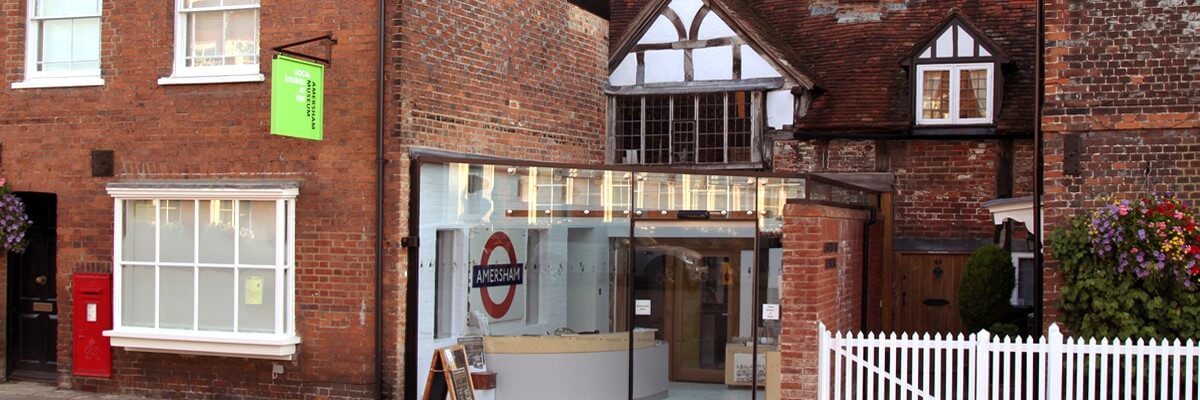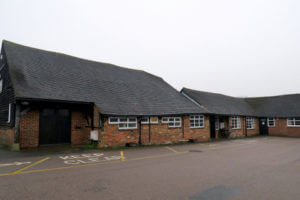The Barn Hall Community Buildings, Woodside Farm, Amersham Common by Alison Bailey
We are incredibly lucky that these ancient barns, today at the heart of Amersham-on-the-Hill, are part of the Amersham and District Community Centre. They are the only survivors of Amersham Common’s rural past that are freely accessible to the public. The barns, dating back to the early 17th century, were once part of an ancient farmstead, most recently known as Woodside Farm. Today surrounded by urban sprawl, 20th century housing developments and our extensive leisure facilities, these barns serve as a reminder of the area’s long history as a rural community.
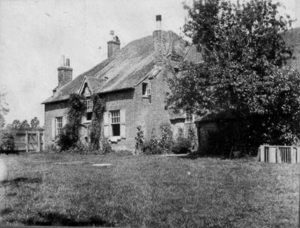
Woodside Farm was one of a number of scattered farmsteads and cottages on the ridge of common land, known as the hamlet of Woodside, and more recently Amersham Common, between the Chess and Misbourne valleys. This common land was a large area of grazing of some 250 acres stretching from what is today, Hyde Heath to the west and Little Chalfont to the east, and adjoining Chesham Bois Common to the North.
Farms were created by building on the edge of the Common and taking in some of the common land for agricultural use. The farmsteads of Woodside included manorial farms such as Raans, prosperous estates such as Beel House, and small tenanted farms named after the yeoman and tenant farmers who lived there, such as Reeves Farm off the White Lion Road (demolished in the 1960s and developed as Little Reeves Avenue). Woodside Farm is earlier recorded as Pratts Farm after the prosperous, yeoman farmer, Timothy Pratt, who lived here with his family at the end of the 17th century. His will, dated 29th May 1704 leaves his wife Ann “All my estate where it hath pleased God to lend me” including “the house wherein I now dwell at Amersham Woodside and the close (farmland) there unto belonging and also all those three houses in Great Missenden”.
After the Pratt family, three generations of the Batchelor family, a farming family from Chesham Bois Common, are recorded as living at the farm, then known as Austins and Pratts. In 1739 Henry Batchelor is documented as paying an annual rent of £21 to William Drake Esquire of Shardeloes.
In addition to the larger farms of Amersham Common, there was a proliferation of cottages, initially built by squatters on the common land, housing agricultural labourers, brickmakers, charcoal makers, blacksmiths, woodmen, turners, beerhouse keepers, and later chairmakers, lacemakers and strawplaiters. 1763 Court books record that tenants at cottages at Austins and Pratts Farm included Joseph Saunders, husbandman (farmer), John Nash, cordwainer (shoemaker) and John Loveday, draper (cloth merchant). Villagers supplemented their livelihood by grazing cattle on the common pasture, which consisted of meadows, woodland and wasteland. Pigs were fattened in the woods on acorns and beechnuts for winter killing. Consequently the Common was an integral part of the rural economy and of utmost importance to the local people.
Tracks crossed the Common with the main track becoming the Amersham to Rickmansworth Road. The Amersham section of this road is today called Woodside Road echoing this ancient history. The road was later turnpiked as the Reading to Hatfield Road with a turnpike collector’s house built near Beel House. There were six pubs on the Common with the White Lion and the Black Horse (now gone) serving travelers on the road. The Boot and Slipper, the Red Lion (illegally demolished by a developer), the Pheasant (under threat) and the Pineapple (now the Pomeroy) all served the local cottagers which shows how large the population was in these scattered dwellings.
In 1815 Amersham Common was finally enclosed by an Act of Parliament. This meant that the large fields or commons were divided into smaller fields each with an individual owner. A large part of Amersham Common was allocated to William Henry Pomeroy and his brother, Kendar Mason, who owned Beel House and several farms on the south side of the Common. According to Julian Hunt’s A History of Amersham “Thomas Tyrwhitt-Drake of Shardeloes accepted a relatively small part of Amersham Common, probably because the commissioners were also dividing Wycombe Heath, where he successfully claimed a large allotment near his home”. In addition to Woodside Farm, Tyrwhitt-Drake also owned neighbouring Hyrons Farm and Weedon Hill. His allocation of Amersham Common would have been around these farms.
This Act was incredibly unpopular locally as it meant that landowners could charge higher rent to the people working the land. A great upheaval, which changed the face of the countryside, the Enclosure Acts lead to rural decline and hardship with many people leaving the country to work in cities in industrial factories. This decline led to overcrowding in the district’s workhouses, the last resort of the desperate poor, and in 1837, the decision was taken to build a large workhouse in Amersham which could hold up to 330 inmates.
Woodside Farm has long been associated with the important Quaker family, the Peningtons. According to oral tradition and many written accounts, it was believed that Woodside Farm was the semi-derelict farm that Mary Penington bought in the 1670s when her husband, the persecuted Quaker theologian Isaac Penington, was imprisoned in Aylesbury Jail. Mary’s son-in-law William Penn was the founder of the colony of Pennsylvania and many of her descendants settled there. However according to Julian Hunt, Beel House in Little Chalfont was known as Penningtons in the 18th Century and is more likely to have been the home of the Penington Quaker family. Indeed Woodside Farm, always part of the hamlet of Woodside, was still known as Pratts Farm until the 1830s.

The persistence of the Quaker association is perhaps due to the local belief that a hidden room in the farm was a secret Quaker meeting place. However this room may have an even earlier origin, dating from previous religious persecutions. According to Granville Squiers’ book Secret Hiding Places – the origins, histories and descriptions of English secret hiding places used by Priests, Cavaliers, Jacobites and Smugglers there exists an “ upper room measuring eighteen foot by twenty, which has no entrance except by a trapdoor in an outside wall. It is situated over the dairy, and there are indications that its two original doors were blocked up.
Against the centre of one wall an oblong space has been railed off by a lath and plaster partition, which from its size and shape looks remarkably like the railing for an altar. The altar rail, if such it was, is not a feature of their (Quaker) places of meeting. At the same time there are the local traditions of its secrecy and its appearance to be taken into consideration, and it appears quite likely to have been a Catholic place of worship.”
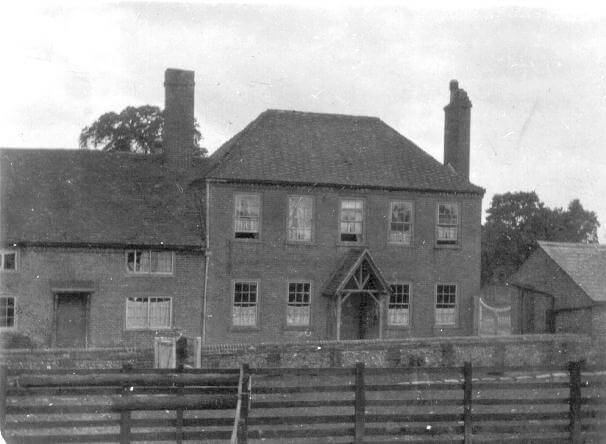
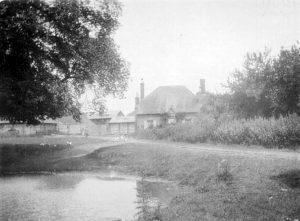
When the brothers, Edward and William Weller bought the farm in 1838, John Thomas Stratton and his wife Jane were farming the 100 acres of land then known as Woodside Farm. At that time the Weller Brewery was the largest employer and most important business in Amersham, dating back to the 1770s. According to the 1851 census the brewery directly employed 45 men to brew beer and an additional 12 draymen to distribute it to the various tied properties.
The Weller interest in the farm, their first diversification away from the brewing industry, may have been motivated by the local debate on the possible benefits of bringing the railway to Amersham. In the 1851 census William Statham, farm bailiff to William Weller is living at Woodside Farm which now has 138 acres and 14 labourers. By the 1880s the Tyrwhitt-Drake family had eventually agreed to sell some of their land to the Metropolitan Railway. This land was mainly from Weedon Hill and Hyrons Farm on the top of the ridge to the north of their estate which meant that the railway would not be seen from Shardeloes. In 1887 George Weller sold 44 acres of the neighbouring Woodside Farm land to the railway company, capitalising on his earlier investment and the Metropolitan Railway opened the extension from Chalfont Road to Aylesbury in 1892.

George Weller was one of the first of the local businessmen to appreciate the new development opportunities heralded by the arrival of the railway. In 1893, opposite the newly built railway station, he built the Station Hotel (later known as the Iron Horse which was demolished in 2004 to be replaced by a block of flats and the Coriander Restaurant), transferring the licence from the Black Horse which he then closed down. He also laid out building plots along the new Station Road where it passed through Woodside Farm land. At this time George Weller was living in grand style at the Plantation, Amersham Common which he had improved and extended after buying it from Lord Chesham in 1885.
Wellers Brewery continued as Amersham’s principal employer until 1929, when George’s son Gerrard, who managed it, decided not to continue and the entire business, including the brewery, the maltings, Barn Meadow and 132 freehold licensed premises and 10 leasehold licensed properties was put up for auction. Although the Wellers made generous payments to all their past employees the sudden sale of the brewery caused considerable bitterness in the area. When Benskins bought it for £360,000 (South Bucks Free Press, 27 September 1929) they were only interested in the pubs and immediately sold off the rest of the business.
According to Nicholas Salmon’s Amersham, an English Market Town
“It is possible that it was the ill-feeling engendered by the sale of the brewery that hastened the death of Mr. George Weller for he died at his home at The Plantation shortly after on 20 October 1929 at the age of 84 (Bucks Examiner, 25 October 1929, p.11). When the 87 acre Plantation estate was sold to the Metropolitan Railway Country Estates for £18,000 the following year it finally severed a link the Weller family had had with the town that had lasted for over 150 years.” The Plantation was sold and eventually demolished for redevelopment in 1976.
21st November 1929 a livestock auction was held at Woodside Farm which had been farmed by Frederick Denning since the beginning of the 20th century. According to an advertisement in the Bucks Examiner of 15th November 1929, this auction comprised of: 50 short horn cattle, viz: 28 dairy cows, 12 two to three years old heifers, 9 head of young stock and 1 bull; 6 carthorses; 2 sows with litters; 150 head of poultry; 200 tons of mangolds and swedes; the straw, chaff and manure.
The 1930 sale of the Plantation Estate included the remaining land and buildings of Woodside Farm. According to the Bucks Examiner the site was “soon to be covered with 535 semi-detached houses (priced at £875 upwards) and 51 shops.” The Metropolitan Railway Country Estates Ltd went on to build the last of their Metro-land developments on the land but did not complete everything on the original plan due to poor sales and the interruption of the Second World War. The land remained undeveloped until the King George V Playing Fields, Amersham Community and Leisure Centre and council offices were built later in the 20th century.
What remained of Woodside Farm was then let to William Darvill, ‘a forage, manure, sand and gravel merchant’ according to the 1935 directory. Still living in the farmhouse in the 1941 directory the business is listed as Darvill, Wm & Son, Haulage Contractors.
The photos below came from the sale brochure advertising the farm for sale for £5,500 just after WW2.
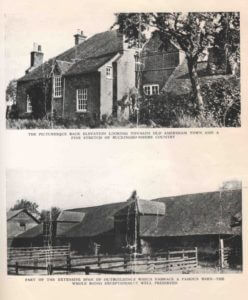
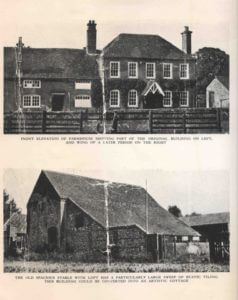

In 1948 Amersham Rural and District Council acquired the buildings in a very dilapidated state (the small barn had been used for mushroom growing!) together with 18 acres of land, for development as a Civic Centre site. In 1951 the Amersham and District Community Association was founded with the aim of establishing a Community Centre and a survey of the farm was undertaken to assess the suitability of the farm buildings. Luckily it was decided that as the main timbers were sound, the buildings were worthy of restoration and Messrs. F Taylor and Sons of Woodside Road were engaged as the main building contractors. At this time there was an upholstery business based at the farm and J Darvill was listed as living in the farmhouse.
The details of the restoration was recorded in a booklet published June 1956 to commemorate the handing over of the buildings to the Amersham and District Community Association. According to Julian Hunt, the warden, Bernard Colclough, now lived in Woodside Farmhouse. The site later accommodated the library (1961), a swimming pool (1966) and a youth centre (1970). The old farmhouse was demolished in the late 1960s.

Since the 1600s these barns have played an important role in Amersham’s story; from its rural beginnings, it’s tradition of non-conformism and religious persecution, the devastating effect of the Act of Enclosure, the association with important Weller family, the transformation of the area brought about by the arrival of the Metropolitan railway and the 20th century development of Amersham-on-the-Hill and Metro-land.

Not only are they of historical importance and value, the old farmyard buildings have provided excellent community facilities for more than 60 years and are in constant use throughout the week. They are used as a meeting place by numerous clubs including bridge clubs, photographic and philatelic societies, and the University of the Third Age. They are regularly booked for talks, social events and arts groups and it would be a tragedy if these beautiful buildings were not adequately funded in the future or even worse demolished as part of the re-development of the entire site. The proposed creation of a new state-of-the-art leisure and community hub offers Amersham’s community an exciting future but we should not lose an important part of our heritage to create it, especially when so much has already been lost.
Sources:
Woodside Farm Past Present and Future booklet June 1956
A History of Amersham Julian Hunt 2001
Julian Hunt’s research notes for A History of Amersham donated to Amersham Museum
Amersham; an English Market Town Nicholas Salmon 1991
www.quakers-chilterns-area.org.uk
Secret Hiding Places – the origins, histories and descriptions of English secret hiding places used by Priests, Cavaliers, Jacobites and Smugglers Granville Squiers 1934

